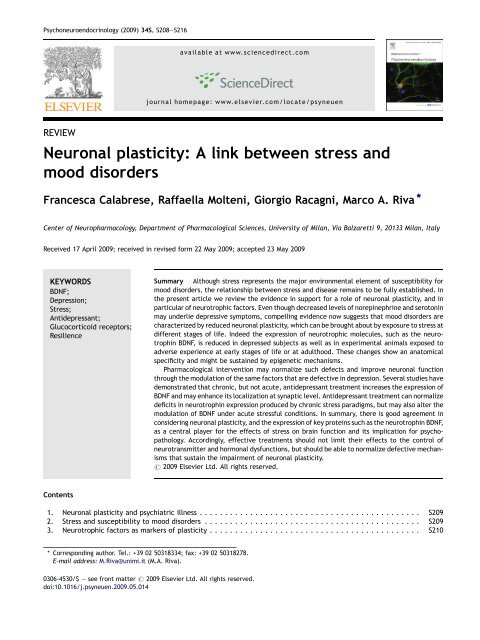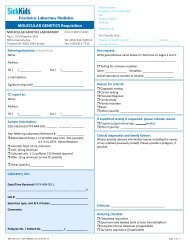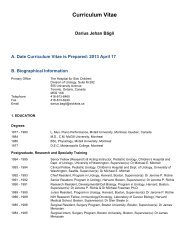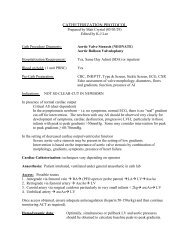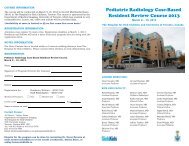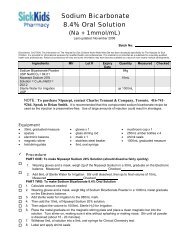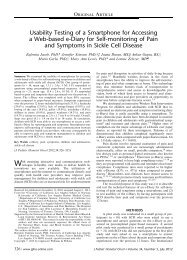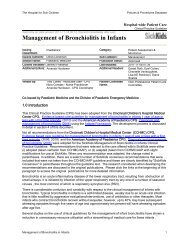Neuronal plasticity: A link between stress and mood disorders
Neuronal plasticity: A link between stress and mood disorders
Neuronal plasticity: A link between stress and mood disorders
You also want an ePaper? Increase the reach of your titles
YUMPU automatically turns print PDFs into web optimized ePapers that Google loves.
Psychoneuroendocrinology (2009) 34S, S208—S216<br />
REVIEW<br />
<strong>Neuronal</strong> <strong>plasticity</strong>: A <strong>link</strong> <strong>between</strong> <strong>stress</strong> <strong>and</strong><br />
<strong>mood</strong> <strong>disorders</strong><br />
Francesca Calabrese, Raffaella Molteni, Giorgio Racagni, Marco A. Riva *<br />
Center of Neuropharmacology, Department of Pharmacological Sciences, University of Milan, Via Balzaretti 9, 20133 Milan, Italy<br />
Received 17 April 2009; received in revised form 22 May 2009; accepted 23 May 2009<br />
KEYWORDS<br />
BDNF;<br />
Depression;<br />
Stress;<br />
Antidepressant;<br />
Glucocorticoid receptors;<br />
Resilience<br />
Contents<br />
available at www.sciencedirect.com<br />
journal homepage: www.elsevier.com/locate/psyneuen<br />
Summary Although <strong>stress</strong> represents the major environmental element of susceptibility for<br />
<strong>mood</strong> <strong>disorders</strong>, the relationship <strong>between</strong> <strong>stress</strong> <strong>and</strong> disease remains to be fully established. In<br />
the present article we review the evidence in support for a role of neuronal <strong>plasticity</strong>, <strong>and</strong> in<br />
particular of neurotrophic factors. Even though decreased levels of norepinephrine <strong>and</strong> serotonin<br />
may underlie depressive symptoms, compelling evidence now suggests that <strong>mood</strong> <strong>disorders</strong> are<br />
characterized by reduced neuronal <strong>plasticity</strong>, which can be brought about by exposure to <strong>stress</strong> at<br />
different stages of life. Indeed the expression of neurotrophic molecules, such as the neurotrophin<br />
BDNF, is reduced in depressed subjects as well as in experimental animals exposed to<br />
adverse experience at early stages of life or at adulthood. These changes show an anatomical<br />
specificity <strong>and</strong> might be sustained by epigenetic mechanisms.<br />
Pharmacological intervention may normalize such defects <strong>and</strong> improve neuronal function<br />
through the modulation of the same factors that are defective in depression. Several studies have<br />
demonstrated that chronic, but not acute, antidepressant treatment increases the expression of<br />
BDNF <strong>and</strong> may enhance its localization at synaptic level. Antidepressant treatment can normalize<br />
deficits in neurotrophin expression produced by chronic <strong>stress</strong> paradigms, but may also alter the<br />
modulation of BDNF under acute <strong>stress</strong>ful conditions. In summary, there is good agreement in<br />
considering neuronal <strong>plasticity</strong>, <strong>and</strong> the expression of key proteins such as the neurotrophin BDNF,<br />
as a central player for the effects of <strong>stress</strong> on brain function <strong>and</strong> its implication for psychopathology.<br />
Accordingly, effective treatments should not limit their effects to the control of<br />
neurotransmitter <strong>and</strong> hormonal dysfunctions, but should be able to normalize defective mechanisms<br />
that sustain the impairment of neuronal <strong>plasticity</strong>.<br />
# 2009 Elsevier Ltd. All rights reserved.<br />
1. <strong>Neuronal</strong> <strong>plasticity</strong> <strong>and</strong> psychiatric illness . . . . . . . . . . . . . . . . . . . . . . . . . . . . . . . . . . . . . . . . . . . . S209<br />
2. Stress <strong>and</strong> susceptibility to <strong>mood</strong> <strong>disorders</strong> . . . . . . . . . . . . . . . . . . . . . . . . . . . . . . . . . . . . . . . . . . . S209<br />
3. Neurotrophic factors as markers of <strong>plasticity</strong> . . . . . . . . . . . . . . . . . . . . . . . . . . . . . . . . . . . . . . . . . . S210<br />
* Corresponding author. Tel.: +39 02 50318334; fax: +39 02 50318278.<br />
E-mail address: M.Riva@unimi.it (M.A. Riva).<br />
0306-4530/$ — see front matter # 2009 Elsevier Ltd. All rights reserved.<br />
doi:10.1016/j.psyneuen.2009.05.014
Stress, neurotrophic factors <strong>and</strong> depression S209<br />
4. BDNF: a neurotrophin with multiple sites of regulation . . . . . . . . . . . . . . . . . . . . . . . . . . . . . . . . . . . . S210<br />
5. Neurotrophic factors in depression. . . . . . . . . . . . . . . . . . . . . . . . . . . . . . . . . . . . . . . . . . . . . . . . . S211<br />
6. Modulation of BDNF expression by <strong>stress</strong> . . . . . . . . . . . . . . . . . . . . . . . . . . . . . . . . . . . . . . . . . . . . . S211<br />
7. Modulation of BDNF by antidepressant treatment . . . . . . . . . . . . . . . . . . . . . . . . . . . . . . . . . . . . . . . S212<br />
8. Antidepressant treatment modulate <strong>stress</strong>-induced changes of BDNF . . . . . . . . . . . . . . . . . . . . . . . . . . . S212<br />
9. Concluding remarks . . . . . . . . . . . . . . . . . . . . . . . . . . . . . . . . . . . . . . . . . . . . . . . . . . . . . . . . . . S214<br />
References . . . . . . . . . . . . . . . . . . . . . . . . . . . . . . . . . . . . . . . . . . . . . . . . . . . . . . . . . . . . . . . . S214<br />
1. <strong>Neuronal</strong> <strong>plasticity</strong> <strong>and</strong> psychiatric illness<br />
<strong>Neuronal</strong> <strong>plasticity</strong> refers to the ability of the nervous system<br />
to respond <strong>and</strong> adapt to environmental challenges <strong>and</strong><br />
encompasses a series of functional <strong>and</strong> structural mechanisms<br />
that may lead to neuronal remodelling, formation of<br />
novel synapses <strong>and</strong> birth of new neurons. However, in a<br />
broader sense, neuronal <strong>plasticity</strong> is intimately <strong>link</strong>ed to<br />
cellular responsiveness <strong>and</strong> may therefore be considered<br />
an index of the neuronal capability to adapt its function to<br />
a different dem<strong>and</strong>. Failure of such mechanisms might<br />
enhance the susceptibility to environmental challenges, such<br />
as <strong>stress</strong>, <strong>and</strong> ultimately lead to psychopathology. That is to<br />
say that the brain, or more specifically, some brain structures<br />
or circuits, may become more vulnerable by loosing progressively<br />
(or suddenly) the ability to adapt <strong>and</strong> maintain their<br />
homeostasis. The manifestation of such vulnerability can be<br />
quite different according to the pathologic condition <strong>and</strong><br />
may lead to overt degeneration (as occurring in neurodegenerative<br />
<strong>disorders</strong>) or to more subtle changes, leading to<br />
functional impairment, which represents a feature of psychiatric<br />
illness.<br />
During the last few years it has indeed become apparent<br />
that several psychiatric conditions, such as <strong>mood</strong> <strong>disorders</strong>,<br />
are associated with deficits or impairment of neuronal <strong>plasticity</strong><br />
(Castren, 2005; Krishnan <strong>and</strong> Nestler, 2008; Pittenger<br />
<strong>and</strong> Duman, 2008). Although for many years depression has<br />
been <strong>link</strong>ed to abnormalities in monoaminergic neurotransmission,<br />
it is now well accepted that this condition is characterized<br />
by profound alterations of brain function <strong>and</strong><br />
responsiveness. Hence depressed subjects display an inability<br />
to cope or adapt to the environment <strong>and</strong> may be more<br />
vulnerable to challenging experiences. These abnormalities<br />
may be intimately <strong>link</strong>ed with neuronal <strong>plasticity</strong> <strong>and</strong> the<br />
ability to modulate a cascade of events from intracellular<br />
signaling mechanisms to gene expression.<br />
Although the individual susceptibility threshold to environmental<br />
events may be genetically determined, it is believed<br />
that life events occurring during brain development may be<br />
critical for later psychopathology. Traumatic experiences<br />
occurring early in life may herein disrupt the correct program<br />
of maturation <strong>and</strong> eventually impact on brain function leading<br />
to a deterioration of neuronal <strong>plasticity</strong>. Indeed the brains of<br />
depressed subjects show structural abnormalities <strong>and</strong> reduced<br />
expression of several markers for neuronal function <strong>and</strong> viability,<br />
among which neurotrophic factors seem to be playing a<br />
pivotal role (aan het Rot et al., 2009; Sheline et al., 2003).<br />
These new concepts imply a reconsideration of the<br />
mechanisms that may be relevant for clinical achievements.<br />
In agreement with the well-known delay for therapeutic<br />
responses, psychotropic drugs, should be able to restore<br />
these defective systems around a physiological set point in<br />
order to alleviate symptoms <strong>and</strong> reduce the susceptibility to<br />
environmental challenges. In a word, these treatments might<br />
contribute to maintain stability.<br />
We will discuss neuronal <strong>plasticity</strong> in the context of <strong>stress</strong>related<br />
situations <strong>and</strong> <strong>mood</strong> <strong>disorders</strong> by focusing on neurotrophic<br />
factors, <strong>and</strong> in particular the neurotrophin brainderived<br />
neurotrophic factor (BDNF), although several other<br />
mechanisms should also be taken into account, since most of<br />
these systems are interrelated <strong>and</strong> may represent different<br />
facets of the same condition.<br />
2. Stress <strong>and</strong> susceptibility to <strong>mood</strong><br />
<strong>disorders</strong><br />
Stress represents the major precipitating factor in <strong>mood</strong> <strong>disorders</strong>.<br />
It may be inferred that affected subjects have a<br />
different threshold for <strong>stress</strong> susceptibility, which means that<br />
mechanisms that are required to cope with <strong>stress</strong> can be<br />
altered or less functional. The effects of <strong>stress</strong> on brain<br />
function depend on the timing <strong>and</strong> duration of the adverse<br />
experience. As already mentioned, adverse events early in life<br />
can be particularly relevant for later psychopathology since<br />
they will impact on structures that are not fully matured.<br />
According to the period when the adverse experience is taking<br />
place, different structures can be affected. Another critical<br />
factor is the duration of the <strong>stress</strong>ful experience according to<br />
the concept of allostasis <strong>and</strong> allostastic load (McEwen, 2000).<br />
Indeed the same mediators or system involved in the adaptation<br />
to acute challenges, can also participate in pathological<br />
effects determined by prolonged repetitive exposure to <strong>stress</strong>ful<br />
conditions. For example within the hippocampus, a mild<br />
<strong>stress</strong> can enhance learning <strong>and</strong> memory (Luine et al., 1996),<br />
whereas chronic or severe <strong>stress</strong>ors, as well as high doses of<br />
glucocorticoid, have detrimental effects on hippocampus<br />
dependent memory (Sapolsky, 2003) <strong>and</strong> impair LTP (Kim<br />
<strong>and</strong> Diamond, 2002). Sustained <strong>stress</strong> or glucocorticoid levels<br />
can lead to neuronal atrophy, in hippocampus <strong>and</strong> prefrontal<br />
cortex, whereas other regions, such as the amygdala, can<br />
become hypertrophic (Sapolsky, 2003). These changes resemble<br />
functional <strong>and</strong> structural alterations found in depressed<br />
subjects (aan het Rot et al., 2009; Sheline et al., 2003),<br />
suggesting that they may indeed represent a long-lasting<br />
consequence of <strong>stress</strong> on a vulnerable individual.<br />
Several mechanisms can be responsible for these alterations.<br />
First of all there is a well-established dysfunction of the<br />
hypothalamus—pituitary—adrenal (HPA) axis, according to<br />
which altered expression <strong>and</strong> function of glucocorticoid<br />
receptors in the hypothalamus <strong>and</strong> the hippocampus may<br />
lead to reduced feed-back that is responsible for elevated<br />
levels of circulating glucocorticoids <strong>and</strong> protracted responses
S210 F. Calabrese et al.<br />
to <strong>stress</strong>ors. However the effects of <strong>stress</strong> on brain structure<br />
<strong>and</strong> function, <strong>and</strong> its possible relationship to depression<br />
susceptibility, may also be mediated by an impairment of<br />
neuronal <strong>plasticity</strong>. According to this possibility <strong>stress</strong> can<br />
modulate a series of mechanisms that are important for<br />
neuronal resilience. If under acute conditions some of these<br />
mechanisms can be ‘protective’ or may activate ‘defensive’<br />
pathways, more protracted adverse experiences can produce<br />
an impairment of such mechanisms that will ultimately lead<br />
to reduced neuronal <strong>plasticity</strong>. Within this context, neurotrophic<br />
factors may play a central role. Some of these<br />
factors, such as the neurotrophin BDNF, are valuable marker<br />
of neuronal <strong>plasticity</strong> <strong>and</strong> may therefore represent an important<br />
element in order to underst<strong>and</strong> the relationship<br />
<strong>between</strong> <strong>stress</strong> <strong>and</strong> <strong>mood</strong> <strong>disorders</strong>. We will recapitulate<br />
evidence for the involvement of trophic molecules, in particular<br />
BDNF, in <strong>stress</strong> <strong>and</strong> major depression.<br />
3. Neurotrophic factors as markers of<br />
<strong>plasticity</strong><br />
Network construction <strong>and</strong> reorganization, which are the main<br />
processes involved in neuro<strong>plasticity</strong>, are regulated by the<br />
level <strong>and</strong> pattern of synaptic activity generated in the nervous<br />
system. The discovery that excitatory neurotransmitters can<br />
stimulate new gene transcription by triggering an influx of<br />
calcium into postsynaptic suggested a mechanism by which<br />
stimulus-evoked neuronal activity might lead long-lasting<br />
changes in the structure <strong>and</strong> function of the nervous system.<br />
Specifically, activity-dependent gene expression occurs when<br />
the calcium influx induced by synaptic activation initiates<br />
calcium-dependent signaling cascades that drive gene expression<br />
through the activation of specific transcription factors<br />
(West et al., 2002). Among the activity-regulated genes<br />
responsive to neuronal activity, neurotrophic factors (NTFs),<br />
<strong>and</strong> in particular the neurotrophin family, play an important<br />
role. In fact, besides their classical role in supporting neuronal<br />
survival, NTFs finely modulate all the crucial steps of network<br />
construction, from neuronal migration to experience-dependent<br />
refinement of local connections (Poo, 2001). These functions<br />
were first reported based on the observation that during<br />
the development of the nervous system neuron survival<br />
depends on the limited amount of specific NTFs secreted by<br />
target cells (Huang <strong>and</strong> Reichardt, 2001). However, it is now<br />
well established that NTFs are important mediators of neuronal<br />
<strong>plasticity</strong> also in adulthood where they modulate axonal<br />
<strong>and</strong> dendritic growth <strong>and</strong> remodelling, membrane receptor<br />
trafficking, neurotransmitter release, synapse formation <strong>and</strong><br />
function (Lu et al., 2005). The neurotrophin BDNF has emerged<br />
as crucial mediator of neuronal <strong>plasticity</strong>, not only because it is<br />
abundant in brain regions that are particularly relevant for<br />
<strong>plasticity</strong>, but because it shows a remarkable activity-dependent<br />
regulation of its expression <strong>and</strong> secretion (Bramham <strong>and</strong><br />
Messaoudi, 2005), suggesting that it might indeed bridge<br />
experience with enduring change in neuronal function.<br />
4. BDNF: a neurotrophin with multiple sites<br />
of regulation<br />
BDNF is a member of the neurotrophin family that has an<br />
important role in development as well as in adult neuronal<br />
<strong>plasticity</strong>. A number of studies carried out in the last few<br />
years have demonstrated that BDNF has a sophisticated<br />
organization in terms of transcriptional, translational <strong>and</strong><br />
posttranslational regulatory mechanisms.<br />
With regard to BDNF transcription, its gene consists of nine<br />
5 0 untranslated exons (some of which are enriched in the<br />
CNS), each <strong>link</strong>ed to individual promoter regions, <strong>and</strong> a 3 0<br />
coding exon (IX), which codes for the BDNF pre-protein amino<br />
acid sequence (Aid et al., 2007). The transcription of each<br />
exons is driven by separate promoters in turn controlled by an<br />
array of signaling mechanisms, including calcium, CREB,<br />
MEK, MeCP2, CaMKII <strong>and</strong> hormones (Lu, 2003; Molteni<br />
et al., 2009a; Zhou et al., 2006). Furthermore it has been<br />
demonstrated that the transcription of specific BDNF splice<br />
variants is controlled by a variety of epigenetic mechanisms,<br />
including DNA methylation <strong>and</strong> posttranslational modifications<br />
of histones (Lubin et al., 2008; Roth et al., 2009). The<br />
regulation of specific promoters causes the temporal <strong>and</strong><br />
spatial expression of specific BDNF transcripts (Lauterborn<br />
et al., 1996), some of which can undergo trafficking <strong>and</strong><br />
targeting to dendrites (Chiaruttini et al., 2008), a process<br />
that may also be influenced by the 3 0 untranslated region<br />
(UTR) of the neurotrophin (An et al., 2008; Ghosh et al.,<br />
1994).<br />
BDNF is initially synthesized as proform that can either be<br />
cleaved into the mature neurotrophin or transported to the<br />
plasma membrane <strong>and</strong> released in an unprocessed manner.<br />
Several matrix metalloproteases (MMP) as well as plasmin are<br />
responsible for extracellular cleavage of the neurotrophin,<br />
whereas furin <strong>and</strong> specific proconvertases control its intracellular<br />
processing (Schweigreiter, 2006). Differently from<br />
other neurotrophins, BDNF can be secreted through a constitutive<br />
as well as a regulated pathway.<br />
Interestingly, the prodomain of the neurotrophin contains<br />
a single nucleotide polymorphism leading to a Val/Met substitution,<br />
which results in a less efficient sorting of BDNF<br />
protein into the regulated secretory pathway (Chen et al.,<br />
2006). Although, this polymorphism has been associated with<br />
the risk of psychiatric <strong>disorders</strong>, not all studies support these<br />
findings, <strong>and</strong> the overall evidence for an association of BDNF<br />
Val/Met polymorphism with disease risk is still weak (Petryshen<br />
et al., 2009).<br />
The prodomain interacts with sortilin that promote an<br />
appropriate configuration of proBDNF. This, in turn, allows<br />
the sorting motif in the mature domain of BDNF to interact<br />
with carboxypeptidase E (CPE), <strong>and</strong>, therefore, to sort BDNF<br />
into the regulated secretory pathway. Thus, BDNF protein can<br />
be packaged into secretory vescicles (Lessmann et al., 2003)<br />
that are present in both axon terminals (presynaptic site) <strong>and</strong><br />
dendrites (postsynaptic site) of glutamatergic neurons (Fawcett<br />
et al., 1997), from which the neurotrophin can be<br />
released in a Ca ++ -dependent manner. Upon release, proBDNF<br />
<strong>and</strong> mBDNF have divergent activities, since the former binds<br />
with high affinity to p75 NTR leading to apoptosis, whereas<br />
mBDNF binds to TrkB receptors promoting cell survival (Lu<br />
et al., 2005). Activated receptors in general are capable of<br />
triggering a number of signal transduction cascades including<br />
the mitogen-activated protein kinase (MAPK) pathway, the<br />
phosphatidylinositol 3-kinase (PI3K) pathway <strong>and</strong> the phospholipase<br />
C-g (PLC-g) pathway (Huang <strong>and</strong> Reichardt, 2001;<br />
Huang <strong>and</strong> Reichardt, 2003), which can also be used to<br />
monitor neurotrophin release <strong>and</strong> receptor activation.
Stress, neurotrophic factors <strong>and</strong> depression S211<br />
Interestingly, as we will see in the next sections, most of<br />
these events, including transcription, translation <strong>and</strong> synaptic<br />
storage of the neurotrophin, can be modulated by pharmacological<br />
treatments or environmental manipulations,<br />
suggesting that the BDNF system offers multiple sites for<br />
modulation, which lead to changes of neuronal <strong>plasticity</strong> that<br />
will ultimately affect the function <strong>and</strong> structure of selected<br />
brain regions.<br />
5. Neurotrophic factors in depression<br />
Several papers have demonstrated, with different<br />
approaches, the relationship <strong>between</strong> neurotrophic factors<br />
<strong>and</strong> depression.<br />
First of all, postmortem studies suggest that the expression<br />
of selected neurotrophic molecules is altered in the<br />
brain of depressed patients. Accordingly Evans <strong>and</strong> co-workers<br />
have shown a decreased expression of several genes<br />
associated with the fibroblast growth factor family (Evans<br />
et al., 2004). In particular the expression of FGF-1, FGF-2,<br />
<strong>and</strong> their receptors FGFR2 <strong>and</strong> FGFR3, is decreased throughout<br />
the limbic system, whereas the levels of FGF-9 <strong>and</strong> FGF-<br />
12 appear to be up-regulated (Evans et al., 2004). Reduced<br />
BDNF expression (mRNA as well as protein) has been detected<br />
in the hippocampus <strong>and</strong> prefrontal cortex of postmortem<br />
brains from suicide victims (Dwivedi et al., 2003). These<br />
changes were associated with a significant down-regulation<br />
of TrkB, the high affinity receptor of the neurotrophin (Dwivedi<br />
et al., 2003). Moreover, consistent data suggest that<br />
serum BDNF levels are reduced in depressed subjects, an<br />
effect that can be normalized by antidepressant treatment or<br />
electroconvulsive therapy (ECT) (Bocchio-Chiavetto et al.,<br />
2006; Sen et al., 2008).<br />
Large support for a role of neurotrophic factors, <strong>and</strong><br />
related deficits of neuronal <strong>plasticity</strong>, in <strong>mood</strong> <strong>disorders</strong><br />
comes from animal studies, either through the knockout of<br />
genes encoding for neurotrophic factors or through exogenous<br />
administration of recombinant proteins.<br />
Microinjection of FGF-2 into the lateral ventricle of adult<br />
rats at the end of day 1 of the forced swim test induces less<br />
depression-like behaviour on the 2nd day of the test (Turner<br />
et al., 2006). Other neurotrophic molecules, such as VEGF<br />
(vascular endothelial growth factor) or VGF (nonacronymic),<br />
mimic the action of antidepressants in behavioural tests like<br />
the forced swim test or learned helplessness (Hunsberger<br />
et al., 2007; Thakker-Varia et al., 2007; Warner-Schmidt <strong>and</strong><br />
Duman, 2008). Similar finding have been observed with BDNF,<br />
whose infusion into the brain results in antidepressant-like<br />
behaviour (Shirayama et al., 2002).<br />
BDNF’s role in depression has also been extensively studied<br />
in mutant mice. Lack of BDNF is not sufficient to produce<br />
a depressive phenotype (Chourbaji et al., 2004), but the<br />
neurotrophin is required for the behavioural response to<br />
antidepressant since the selective deletion of the BDNF gene<br />
in the hippocampal dentate gyrus, as well as the impaired<br />
function of its high affinity receptor TrkB, prevents behavioural<br />
responses to antidepressant drugs (Adachi et al.,<br />
2008; Monteggia et al., 2004; Saarelainen et al., 2003).<br />
However, BDNF appears to have an opposite role in the<br />
ventral tegmental area (VTA): its over-expression at this<br />
level determines a depression-like phenotype, whereas animals<br />
with a selective knockout of BDNF in the VTA are<br />
protected from the depressive effects produced by the social<br />
defeat <strong>stress</strong> (Berton et al., 2006). These data suggest that<br />
the role of BDNF in <strong>mood</strong> <strong>disorders</strong> <strong>and</strong> <strong>stress</strong> responsiveness<br />
is complex <strong>and</strong> strictly anatomical-dependent.<br />
Further, as we will discuss in more detail later in this<br />
article, antidepressant drugs can up-regulate the expression<br />
of neurotrophic factors, an effect that might normalize<br />
defective systems or increase neuronal <strong>plasticity</strong> through<br />
alternative strategies. In fact ECT <strong>and</strong> antidepressant treatments<br />
increased, in addition to BDNF (see later in the<br />
review), the expression for different neurotrophic molecules,<br />
including FGF-2, VEGF <strong>and</strong> VGF (Maragnoli et al.,<br />
2004; Newton et al., 2003).<br />
6. Modulation of BDNF expression by <strong>stress</strong><br />
A modulation of BDNF by <strong>stress</strong> was originally shown several<br />
years ago (Smith et al., 1995). Since than, evidence has been<br />
produced demonstrating the complex outcome of <strong>stress</strong> on<br />
the BDNF system. Because epidemiological studies have<br />
shown that <strong>stress</strong>ful episodes in early life can increase the<br />
risk to develop depression (Heim et al., 2004), several<br />
authors have investigated the expression of BDNF in animal<br />
models that reproduce exposure to adverse life events.<br />
These paradigms are based on the exposure of pregnant<br />
dams to repetitive <strong>stress</strong> (prenatal <strong>stress</strong>) or rely on the<br />
disruption of mother—pup interaction early in life (maternal<br />
separation). As previously mentioned, the susceptibility to<br />
such events may depend upon the type <strong>and</strong> timing of the<br />
manipulation. Indeed we have shown that strong <strong>stress</strong>ors,<br />
such as a 24 h maternal separation on postnatal day 9 can<br />
reduce BDNF expression in the rat hippocampus (Roceri<br />
et al., 2002), although more protracted manipulations during<br />
gestation or the early phase of postnatal life do not produce<br />
significant changes on hippocampal BDNF levels (Fumagalli<br />
et al., 2004; Koo et al., 2003; Roceri et al., 2004).<br />
Conversely, the length of the manipulation appears to be<br />
more important than the timing for changes that might occur<br />
at cortical level. Prenatal <strong>stress</strong> as well as repeated maternal<br />
separation determine a significant reduction of BDNF levels in<br />
prefrontal cortex of adult animals (Fumagalli et al., 2004; Koo<br />
et al., 2003; Roceri et al., 2004), whereas a single maternal<br />
deprivation did not elicit any change on cortical neurotrophin<br />
expression (Roceri et al., 2002). Hence developmental events<br />
can have enduring effects on BDNF expression that, based on<br />
its role in information processing as well as on cognition, may<br />
contribute to the persistent changes on brain function <strong>and</strong><br />
their relative contribution to psychopathology.<br />
The long-lasting nature of neurotrophin changes appears<br />
to be due epigenetic mechanisms. A recent study has demonstrated<br />
that early maltreatment (exposure of infant rats to a<br />
<strong>stress</strong>ed ‘‘abusive’’ mother 30 min daily during the first<br />
postnatal week) elicited a reduction of BDNF mRNA levels<br />
in prefrontal cortex of adult offspring, which was associated<br />
with an increased methylation of the Bdnf gene on specific<br />
promoters (Roth et al., 2009). These results are of extreme<br />
interest since they could provide a molecular basis for enduring<br />
changes in neuronal <strong>plasticity</strong> that are associated with a<br />
reduced ability to turn on the transcription of activity-regulated<br />
genes, such as the neurotrophin BDNF.<br />
As we have mentioned, the expression of BDNF is also<br />
significantly affected by <strong>stress</strong> at adulthood, although the
S212 F. Calabrese et al.<br />
final outcome depends on several variables, particularly the<br />
duration of <strong>stress</strong> <strong>and</strong> the time elapsed <strong>between</strong> the end of<br />
the <strong>stress</strong>ful experience <strong>and</strong> the sacrifice.<br />
Acute <strong>stress</strong>ors can produce a rapid facilitation of the<br />
BDNF system. In fact a significant <strong>and</strong> transient increase of<br />
BDNF mRNA levels has been observed in the rat (Marmigere<br />
et al., 2003) as well as in the prefrontal <strong>and</strong> cingulate<br />
cortex of rats (Molteni et al., 2001) <strong>and</strong>inthefrontallobe<br />
of mice (Molteni et al., 2009a) exposed to an acute<br />
restraint <strong>stress</strong>.<br />
We have recently shown that an acute <strong>stress</strong> (restraint or<br />
swim) can also regulate the subcellular localization of the<br />
neurotrophin, with a significant increase of the mature form<br />
of the neurotrophin in the synaptic compartment (Molteni<br />
et al., 2009a). The synaptic increase of mBDNF in response to<br />
the acute <strong>stress</strong> may be part of a cellular ‘defensive strategy’<br />
aimed at increasing the pool of the mature neurotrophin<br />
that, upon release, might interact with its high affinity<br />
receptor TrkB <strong>and</strong> promote synaptic function <strong>and</strong> cell survival<br />
(Bramham <strong>and</strong> Messaoudi, 2005; Chao et al., 2006). Interestingly<br />
the increased synaptic levels of BDNF after <strong>stress</strong> are<br />
not observed in animal with a compromised function of<br />
glucocorticoid receptors (Molteni et al., 2009b), which represent<br />
a good model for susceptibility to depression (Ridder<br />
et al., 2005), suggesting that indeed rapid changes in BDNF<br />
under challenging conditions may reflect an active response<br />
strategy to preserve neuronal homeostasis (McEwen, 2008).<br />
Moreover, it has been recently demonstrated that glucocorticoids<br />
can also activate trkB receptor tyrosine kinases in vivo<br />
<strong>and</strong> in vitro, leading to neuroprotective effects (Jeanneteau<br />
et al., 2008), suggesting a further mechanism of integration<br />
<strong>between</strong> glucocorticoid hormones <strong>and</strong> neurotrophins.<br />
If the rapid increase of BDNF expression following a single<br />
<strong>stress</strong> may represent a short-term protective mechanism, a<br />
prolonged <strong>stress</strong>ful experience may have a detrimental<br />
effect on neuro<strong>plasticity</strong>, an observation supported by the<br />
overall negative impact of chronic <strong>stress</strong> on BDNF expression<br />
at hippocampal <strong>and</strong> cortical level. The initial observation of<br />
Smith et al. (1995) reporting reduced BDNF expression in the<br />
rat hippocampus after chronic immobilization <strong>stress</strong> has been<br />
confirmed by several subsequent studies (Nair et al., 2007;<br />
Roceri et al., 2002; Vollmayr et al., 2001). Additionally,<br />
<strong>stress</strong>-induced down-regulation of hippocampal BDNF<br />
expression was observed not only after physical–—but also<br />
following psychological <strong>stress</strong> (Rasmusson et al., 2002). We<br />
found reduced BDNF mRNA levels after different paradigms<br />
of chronic <strong>stress</strong> in rat prefrontal cortex (Fumagalli et al.,<br />
2004; Roceri et al., 2004) <strong>and</strong> in mouse frontal cortex<br />
(Fumagalli et al., 2003). Although the exact mechanism by<br />
which prolonged <strong>stress</strong>ful experiences regulate BDNF is still<br />
unknown, the involvement of hormonal <strong>and</strong> neurotransmitter<br />
systems, has to be taken into consideration (Joca et al., 2007;<br />
Molteni et al., 2009a).<br />
As previously mentioned for developmental manipulations,<br />
also chronic <strong>stress</strong> in adult life can alter the expression<br />
of BDNF, <strong>and</strong> in particular of some of its transcripts, through<br />
epigenetic mechanisms. Indeed, Tsankova <strong>and</strong> collaborators<br />
have shown that chronic defeat <strong>stress</strong> down-regulated total<br />
hippocampal BDNF mRNA levels, primarily through a<br />
decrease of BDNF exon IV <strong>and</strong> VI. Such effect was paralleled<br />
by an increased dimethylation of histone H3 at their relative<br />
promoters (Tsankova et al., 2006).<br />
Furthermore a prior history of <strong>stress</strong> can alter the pattern<br />
of changes produced by adult-onset <strong>stress</strong> on BDNF expression.<br />
For example, chronic immobilization <strong>stress</strong> reduced<br />
BDNF levels in the prefrontal cortex of ‘normal’ rats, while<br />
increasing its gene expression in prenatally <strong>stress</strong>ed rats<br />
(Fumagalli et al., 2004). Similarly acute <strong>stress</strong> is not able<br />
to alter BDNF in rats previously exposed to MD (Nair et al.,<br />
2007; Roceri et al., 2002).<br />
7. Modulation of BDNF by antidepressant<br />
treatment<br />
Since depression is characterized by a reduction of neuronal<br />
<strong>plasticity</strong>, which can be produced as a consequence of<br />
exposure to <strong>stress</strong> at different stages of life, it may be<br />
inferred that effective pharmacological treatments should<br />
be able to correct or normalize such deficits in order to<br />
achieve functional recovery. Indeed, speaking of depression,<br />
a key question has always been why therapeutic<br />
responses with antidepressants could only be achieved after<br />
at least 2—3 weeks of treatment, whereas their synaptic<br />
effects occur without any significant delay. Hence, during<br />
the last decade it has become well accepted the idea that<br />
this delay is required in order to produce neuroadaptive<br />
mechanisms that may enhance neuronal <strong>plasticity</strong> <strong>and</strong> resilience<br />
(Castren, 2005; Kozisek et al., 2008; Pittenger <strong>and</strong><br />
Duman, 2008).<br />
Along this line of reasoning, several studies have shown<br />
that BDNF may mediate the therapeutic action of antidepressants<br />
(Berton <strong>and</strong> Nestler, 2006; Groves, 2007; Martinowich<br />
et al., 2007).TheexpressionofBDNFincreasesinthe<br />
hippocampus in response to repeat but not acute treatment<br />
with major classes of antidepressants (Calabrese et al.,<br />
2007; Castren et al., 2007; Russo-Neustadt <strong>and</strong> Chen,<br />
2005). Despite the well accepted effects of antidepressant<br />
drugs on BDNF expression, during the last 5 years, it has<br />
become apparent that this modulation can occur at several<br />
levels. Transcriptional changes can be due to the selective<br />
modulation of BDNF transcripts (Calabrese et al., 2007;<br />
Russo-Neustadt et al., 2004), an effect that may be related<br />
to the modulation of specific transcription factors. Since<br />
some BDNF mRNA species can undergo dendritic targeting<br />
(Chiaruttini et al., 2008), these changes may also affect the<br />
subcellular distribution of the neurotrophin. Indeed we have<br />
shown that chronic treatment with the novel antidepressant<br />
duloxetine increases the levels of mBDNF in the synaptic<br />
compartment (Calabrese et al., 2007) a mechanism that can<br />
be relevant for the control of the local release of the<br />
neurotrophin. Furthermore antidepressant treatment can<br />
also change the levels <strong>and</strong> the activation of TrkB, the high<br />
affinity receptor of BDNF, <strong>and</strong> its signaling (Duman et al.,<br />
2007; Fumagalli et al., 2005; Saarelainen et al., 2003;<br />
Wyneken et al., 2006).<br />
8. Antidepressant treatment modulate<br />
<strong>stress</strong>-induced changes of BDNF<br />
Since <strong>stress</strong> is a major causative factor in depression, it is<br />
expected that antidepressant drugs could modulate <strong>stress</strong><br />
responsiveness <strong>and</strong> susceptibility, which is altered in affected<br />
individuals.
Stress, neurotrophic factors <strong>and</strong> depression S213<br />
First of all antidepressants can regulate the HPA axis,<br />
whose function is altered in <strong>stress</strong> <strong>and</strong> <strong>mood</strong> <strong>disorders</strong>.<br />
Indeed, it has been found that different <strong>stress</strong>ors decrease<br />
glucocorticoid receptor (GR) levels in the hippocampus (Chen<br />
et al., 2008; Meyer et al., 2001), while antidepressant treatment<br />
can up-regulated their expression (Przegalinski <strong>and</strong><br />
Budziszewska, 1993). Moreover, antidepressant treatment<br />
is able to alter the <strong>stress</strong> responsiveness in term of translocation<br />
of glucocorticoids receptors from the cytoplasm to the<br />
nucleus. We demonstrated that chronic antidepressant treatment<br />
increase the nuclear GR levels after an acute <strong>stress</strong><br />
(Molteni et al., 2009a), in accordance with a previous study<br />
showing that antidepressant increase dexametasone-induced<br />
GR traslocation (Pariante et al., 1997). In a recent study it has<br />
been shown that chronic treatment with different antidepressants<br />
normalizes hippocampal alterations of GR levels<br />
due to prenatal manipulation (Szymanska et al., 2009). Moreover,<br />
the levels of FKBP51, a GR co-chaperon that retains GR<br />
in the cytoplasm, are restored in the prefrontal cortex of the<br />
same animals. These results suggest that GR <strong>and</strong> FKBP51 may<br />
represent key molecules in the alteration of HPA axis seen in<br />
depressed patients. Alterations of GR expression <strong>and</strong> function<br />
have also been reported in human cells <strong>and</strong> some of these<br />
changes may be normalized by antidepressant treatment<br />
(Carvalho <strong>and</strong> Pariante, 2008).<br />
While the studies mentioned above suggest that prolonged<br />
treatment with antidepressant drugs have a positive impact on<br />
neuronal <strong>plasticity</strong>, an important point is to underst<strong>and</strong> if <strong>and</strong><br />
how antidepressants could correct <strong>stress</strong>-induced modifications<br />
or, eventually if they may alter <strong>stress</strong> responsiveness.<br />
With regard to the first issue, it has been demonstrated that<br />
antidepressant treatment can normalize the reduced expression<br />
of BDNF following chronic <strong>stress</strong>. For example chronically<br />
venlafaxine administration is able to restore BDNF levels <strong>and</strong><br />
neurogenesis that are reduced by after an immobilization<br />
<strong>stress</strong> (Xu et al., 2004). Similarly, prolonged treatment with<br />
imipramine normalizes behavioural alterations in the chronic<br />
social defeat <strong>stress</strong> protocol while restoring reduced levels of<br />
the neurotrophin (Tsankova et al., 2006). Both <strong>stress</strong> <strong>and</strong><br />
antidepressant treatment may alter BDNF expression through<br />
epigenetic mechanisms. However while prolonged <strong>stress</strong> may<br />
repress BDNF transcription through a hypermethylation of<br />
histone proteins that lead to a more ‘closed’ chromatin state,<br />
chronic imipramine increases H3 histone acetylation in the<br />
promoter regions of exon IV <strong>and</strong> exon VI, which may overcome<br />
the repressing changes leading to an open chromatin conformation<br />
(Tsankova et al., 2006). These studies provide a good<br />
example of the possibility that disease-related factors (<strong>stress</strong>)<br />
<strong>and</strong> drug treatments may exert their effects on the same<br />
protein although not through overlapping mechanisms.<br />
Since the concept of neuronal <strong>plasticity</strong> implies that adaptive<br />
changes are set in motion in response to ‘external’stimuli,<br />
it is expected that antidepressants should not only improve<br />
compromised neuronal <strong>plasticity</strong> by affecting the expression of<br />
key proteins, but they may also modulate the responsiveness of<br />
these systems under challenging conditions. Accordingly, we<br />
have recently shown that antidepressant drugs do not only<br />
modulate BDNF expression under basal conditions, but can also<br />
alter its responsiveness under challenging circumstances. In<br />
fact we found that total BDNF expression was slightly increased<br />
by chronic duloxetine treatment <strong>and</strong> further enhanced when<br />
antidepressant-treated rats were exposed to a short swim<br />
<strong>stress</strong> (Molteni et al., 2009a). The antidepressant treatment<br />
was able to affect the <strong>stress</strong> modulation of BDNF exon VI,<br />
whereas exon IV was regulated by <strong>stress</strong> independently from<br />
the pharmacological treatment. Moreover, we found that the<br />
subcellular trafficking of the neurotrophin after <strong>stress</strong> was<br />
significantly affected by duloxetine treatment. In fact<br />
only animals that were chronically injected with the antidepressant<br />
showed a significant increase of synaptosomal<br />
mBDNF levels when exposed to the acute challenging condition<br />
(Molteni et al., 2009a). These data suggest that chronic<br />
antidepressant treatment can affect cellular resilience not<br />
only by increasing the expression of ‘protective’ proteins, but<br />
also by altering the coping ability under potential ‘threatening’<br />
situations.<br />
Figure 1 Mechanisms underlying the impact of <strong>stress</strong> or depression on the BDNF system <strong>and</strong> the potential effects of antidepressant<br />
drugs. Stress can reduce the expression of the neurotrophin through epigenetic (1), transcriptional (2 <strong>and</strong> 3) <strong>and</strong> translational mechanisms<br />
(4). On the other h<strong>and</strong> antidepressant drugs can restore normal levels of the neurotrophin by different mechanisms including: increase<br />
histone acetylation or reduced DNA methylation (5) at specific BDNF promoters; increase transcription of different exons (6 <strong>and</strong> 7);<br />
elevated synthesis <strong>and</strong> trafficking of BDNF protein (8); stimulation of protein release <strong>and</strong> increase receptor interaction (9).
S214 F. Calabrese et al.<br />
9. Concluding remarks<br />
In summary, the data herein reviewed suggest a close <strong>link</strong><br />
<strong>between</strong> <strong>stress</strong>, neuronal <strong>plasticity</strong> <strong>and</strong> major depression. We<br />
believe that a putative mechanism through which <strong>stress</strong> can<br />
alter the susceptibility to <strong>mood</strong> <strong>disorders</strong> is the modulation of<br />
neuroplastic molecules, such as neurotrophins. Accordingly,<br />
antidepressant drugs are able to normalize defective<br />
mechanisms that sustain the impairment of neuronal <strong>plasticity</strong><br />
<strong>and</strong> can increase neuronal resilience (Fig. 1). The underst<strong>and</strong>ing<br />
of these adaptive mechanisms may lead to the<br />
identification of molecular targets for the development of<br />
novel <strong>and</strong> more effective drugs.<br />
Conflict of interest<br />
None.<br />
References<br />
aan het Rot, M., Mathew, S.J., Charney, D.S., 2009. Neurobiological<br />
mechanisms in major depressive disorder. CMAJ 180, 305—313.<br />
Adachi, M., Barrot, M., Autry, A.E., Theobald, D., Monteggia, L.M.,<br />
2008. Selective loss of brain-derived neurotrophic factor in the<br />
dentate gyrus attenuates antidepressant efficacy. Biol. Psychiatry<br />
63, 642—649.<br />
Aid, T., Kazantseva, A., Piirsoo, M., Palm, K., Timmusk, T., 2007.<br />
Mouse <strong>and</strong> rat BDNF gene structure <strong>and</strong> expression revisited. J.<br />
Neurosci. Res. 85, 525—535.<br />
An, J.J., Gharami, K., Liao, G.Y., Woo, N.H., Lau, A.G., Vanevski, F.,<br />
et al., 2008. Distinct role of long 3 0 UTR BDNF mRNA in spine<br />
morphology <strong>and</strong> synaptic <strong>plasticity</strong> in hippocampal neurons. Cell<br />
134, 175—187.<br />
Berton, O., McClung, C.A., Dileone, R.J., Krishnan, V., Renthal, W.,<br />
Russo, S.J., et al., 2006. Essential role of BDNF in the mesolimbic<br />
dopamine pathway in social defeat <strong>stress</strong>. Science 311, 864—868.<br />
Berton, O., Nestler, E.J., 2006. New approaches to antidepressant<br />
drug discovery: beyond monoamines. Nat. Rev. Neurosci. 7, 137—<br />
151.<br />
Bocchio-Chiavetto, L., Zanardini, R., Bortolomasi, M., Abate, M.,<br />
Segala, M., Giacopuzzi, M., et al., 2006. Electroconvulsive<br />
therapy (ECT) increases serum brain derived neurotrophic factor<br />
(BDNF) in drug resistant depressed patients. Eur. Neuropsychopharmacol.<br />
16, 620—624.<br />
Bramham, C.R., Messaoudi, E., 2005. BDNF function in adult synaptic<br />
<strong>plasticity</strong>: the synaptic consolidation hypothesis. Prog. Neurobiol.<br />
76, 99—125.<br />
Calabrese, F., Molteni, R., Maj, P.F., Cattaneo, A., Gennarelli, M.,<br />
Racagni, G., et al., 2007. Chronic duloxetine treatment induces<br />
specific changes in the expression of BDNF transcripts <strong>and</strong> in the<br />
subcellular localization of the neurotrophin protein. Neuropsychopharmacology<br />
32, 2351—2359.<br />
Carvalho, L.A., Pariante, C.M., 2008. In vitro modulation of the<br />
glucocorticoid receptor by antidepressants. Stress 11, 411—424.<br />
Castren, E., 2005. Is <strong>mood</strong> chemistry? Nat. Rev. Neurosci. 6, 241—246.<br />
Castren, E., Voikar, V., Rantamaki, T., 2007. Role of neurotrophic<br />
factors in depression. Curr. Opin. Pharmacol. 7, 18—21.<br />
Chao, M.V., Rajagopal, R., Lee, F.S., 2006. Neurotrophin signalling in<br />
health <strong>and</strong> disease. Clin. Sci. (Lond.) 110, 167—173.<br />
Chen, J.X., Tang, Y.T., Yang, J.X., 2008. Changes of glucocorticoid<br />
receptor <strong>and</strong> levels of CRF mRNA, POMC mRNA in brain of chronic<br />
immobilization <strong>stress</strong> rats. Cell. Mol. Neurobiol. 28, 237—244.<br />
Chen, Z.Y., Jing, D., Bath, K.G., Ieraci, A., Khan, T., Siao, C.J., et al.,<br />
2006. Genetic variant BDNF (Val66Met) polymorphism alters<br />
anxiety-related behavior. Science 314, 140—143.<br />
Chiaruttini, C., Sonego, M., Baj, G., Simonato, M., Tongiorgi, E.,<br />
2008. BDNF mRNA splice variants display activity-dependent<br />
targeting to distinct hippocampal laminae. Mol. Cell. Neurosci.<br />
37, 11—19.<br />
Chourbaji, S., Hellweg, R., Br<strong>and</strong>is, D., Zorner, B., Zacher, C., Lang,<br />
U.E., et al., 2004. Mice with reduced brain-derived neurotrophic<br />
factor expression show decreased choline acetyltransferase<br />
activity, but regular brain monoamine levels <strong>and</strong> unaltered emotional<br />
behavior. Brain Res. Mol. Brain Res. 121, 28—36.<br />
Duman, C.H., Schlesinger, L., Kodama, M., Russell, D.S., Duman,<br />
R.S., 2007. A role for MAP kinase signaling in behavioral models of<br />
depression <strong>and</strong> antidepressant treatment. Biol. Psychiatry 61,<br />
661—670.<br />
Dwivedi, Y., Rizavi, H.S., Conley, R.R., Roberts, R.C., Tamminga,<br />
C.A., P<strong>and</strong>ey, G.N., 2003. Altered gene expression of brainderived<br />
neurotrophic factor <strong>and</strong> receptor tyrosine kinase B in<br />
postmortem brain of suicide subjects. Arch. Gen. Psychiatry 60,<br />
804—815.<br />
Evans, S.J., Choudary, P.V., Neal, C.R., Li, J.Z., Vawter, M.P., Tomita,<br />
H., et al., 2004. Dysregulation of the fibroblast growth factor<br />
system in major depression. Proc. Natl. Acad. Sci. U.S.A. 101,<br />
15506—15511.<br />
Fawcett, J.P., Aloyz, R., McLean, J.H., Pareek, S., Miller, F.D.,<br />
McPherson, P.S., et al., 1997. Detection of brain-derived neurotrophic<br />
factor in a vesicular fraction of brain synaptosomes. J.<br />
Biol. Chem. 272, 8837—8840.<br />
Fumagalli, F., Bedogni, F., Perez, J., Racagni, G., Riva, M.A., 2004.<br />
Corticostriatal brain-derived neurotrophic factor dysregulation in<br />
adult rats following prenatal <strong>stress</strong>. Eur. J. Neurosci. 20, 1348—<br />
1354.<br />
Fumagalli, F., Molteni, R., Calabrese, F., Frasca, A., Racagni, G.,<br />
Riva, M.A., 2005. Chronic fluoxetine administration inhibits<br />
extracellular signal-regulated kinase 1/2 phosphorylation in rat<br />
brain. J. Neurochem. 93, 1551—1560.<br />
Fumagalli, F., Racagni, G., Colombo, E., Riva, M.A., 2003. BDNF gene<br />
expression is reduced in the frontal cortex of dopamine transporter<br />
knockout mice. Mol. Psychiatry 8, 898—899.<br />
Ghosh, A., Carnahan, J., Greenberg, M.E., 1994. Requirement for<br />
BDNF in activity-dependent survival of cortical neurons. Science<br />
263, 1618—1623.<br />
Groves, J.O., 2007. Is it time to reassess the BDNF hypothesis of<br />
depression? Mol. Psychiatry. 12, 1079—1088 Epub 2007 Aug 14.<br />
Review.<br />
Heim, C., Plotsky, P.M., Nemeroff, C.B., 2004. Importance of studying<br />
the contributions of early adverse experience to neurobiological<br />
findings in depression. Neuropsychopharmacology 29, 641—<br />
648.<br />
Huang, E.J., Reichardt, L.F., 2001. Neurotrophins: roles in neuronal<br />
development <strong>and</strong> function. Annu. Rev. Neurosci. 24, 677—736.<br />
Huang, E.J., Reichardt, L.F., 2003. Trk receptors: roles in neuronal<br />
signal transduction. Annu. Rev. Biochem. 72, 609—642.<br />
Hunsberger, J.G., Newton, S.S., Bennett, A.H., Duman, C.H., Russell,<br />
D.S., Salton, S.R., et al., 2007. Antidepressant actions of the<br />
exercise-regulated gene VGF. Nat. Med. 13, 1476—1482.<br />
Jeanneteau, F., Garabedian, M.J., Chao, M.V., 2008. Activation of Trk<br />
neurotrophin receptors by glucocorticoids provides a neuroprotective<br />
effect. Proc. Natl. Acad. Sci. U.S.A. 105, 4862—4867.<br />
Joca, S.R., Ferreira, F.R., Guimaraes, F.S., 2007. Modulation of <strong>stress</strong><br />
consequences by hippocampal monoaminergic, glutamatergic<br />
<strong>and</strong> nitrergic neurotransmitter systems. Stress 10, 227—249.<br />
Kim, J.J., Diamond, D.M., 2002. The <strong>stress</strong>ed hippocampus, synaptic<br />
<strong>plasticity</strong> <strong>and</strong> lost memories. Nat. Rev. Neurosci. 3, 453—462.<br />
Koo, J.W., Park, C.H., Choi, S.H., Kim, N.J., Kim, H.S., Choe, J.C.,<br />
et al., 2003. The postnatal environment can counteract prenatal<br />
effects on cognitive ability, cell proliferation, <strong>and</strong> synaptic protein<br />
expression. FASEB J. 17, 1556—1558.<br />
Kozisek, M.E., Middlemas, D., Bylund, D.B., 2008. Brain-derived<br />
neurotrophic factor <strong>and</strong> its receptor tropomyosin-related kinase
Stress, neurotrophic factors <strong>and</strong> depression S215<br />
B in the mechanism of action of antidepressant therapies. Pharmacol.<br />
Ther. 117, 30—51.<br />
Krishnan, V., Nestler, E.J., 2008. The molecular neurobiology of<br />
depression. Nature 455, 894—902.<br />
Lauterborn, J.C., Rivera, S., Stinis, C.T., Hayes, V.Y., Isackson, P.J.,<br />
Gall, C.M., 1996. Differential effects of protein synthesis inhibition<br />
on the activity-dependent expression of BDNF transcripts:<br />
evidence for immediate-early gene responses from specific promoters.<br />
J. Neurosci. 16, 7428—7436.<br />
Lessmann, V., Gottmann, K., Malcangio, M., 2003. Neurotrophin<br />
secretion: current facts <strong>and</strong> future prospects. Prog. Neurobiol.<br />
69, 341—374.<br />
Lu, B., 2003. BDNF <strong>and</strong> activity-dependent synaptic modulation.<br />
Learn. Mem. 10, 86—98.<br />
Lu, B., Pang, P.T., Woo, N.H., 2005. The yin <strong>and</strong> yang of neurotrophin<br />
action. Nat. Rev. Neurosci. 6, 603—614.<br />
Lubin, F.D., Roth, T.L., Sweatt, J.D., 2008. Epigenetic regulation of<br />
BDNF gene transcription in the consolidation of fear memory. J.<br />
Neurosci. 28, 10576—10586.<br />
Luine, V., Martinez, C., Villegas, M., Magarinos, A.M., McEwen, B.S.,<br />
1996. Restraint <strong>stress</strong> reversibly enhances spatial memory performance.<br />
Physiol. Behav. 59, 27—32.<br />
Maragnoli, M.E., Fumagalli, F., Gennarelli, M., Racagni, G., Riva,<br />
M.A., 2004. Fluoxetine <strong>and</strong> olanzapine have synergistic effects in<br />
the modulation of fibroblast growth factor 2 expression within the<br />
rat brain. Biol. Psychiatry 55, 1095—1102.<br />
Marmigere, F., Givalois, L., Rage, F., Arancibia, S., Tapia-Arancibia,<br />
L., 2003. Rapid induction of BDNF expression in the hippocampus<br />
during immobilization <strong>stress</strong> challenge in adult rats. Hippocampus<br />
13, 646—655.<br />
Martinowich, K., Manji, H., Lu, B., 2007. New insights into BDNF<br />
function in depression <strong>and</strong> anxiety. Nat. Neurosci. 10, 1089—<br />
1093.<br />
McEwen, B.S., 2000. Allostasis <strong>and</strong> allostatic load: implications for<br />
neuropsychopharmacology. Neuropsychopharmacology 22, 108—<br />
124.<br />
McEwen, B.S., 2008. Central effects of <strong>stress</strong> hormones in health <strong>and</strong><br />
disease: underst<strong>and</strong>ing the protective <strong>and</strong> damaging effects of<br />
<strong>stress</strong> <strong>and</strong> <strong>stress</strong> mediators. Eur. J. Pharmacol. 583, 174—185.<br />
Meyer, U., van Kampen, M., Isovich, E., Flugge, G., Fuchs, E., 2001.<br />
Chronic psychosocial <strong>stress</strong> regulates the expression of both GR<br />
<strong>and</strong> MR mRNA in the hippocampal formation of tree shrews.<br />
Hippocampus 11, 329—336.<br />
Molteni, R., Calabrese, F., Cattaneo, A., Mancini, M., Gennarelli, M.,<br />
Racagni, G., Riva, M.A., 2009a. Acute <strong>stress</strong> responsiveness of the<br />
neurotrophin BDNF in the rat hippocampus is modulated by<br />
chronic treatment with the antidepressant duloxetine. Neuropsychopharmacology.<br />
34, 1523—1532.<br />
Molteni, R., Calabrese, F., Chourbaji, S., Br<strong>and</strong>wein, C., Racagni, G.,<br />
Gass, P., et al., 2009b. Depression-prone mice with reduced<br />
glucocorticoid receptor expression display an altered <strong>stress</strong>dependent<br />
regulation of brain-derived neurotrophic factor <strong>and</strong><br />
activity-regulated cytoskeleton-associated protein. J. Psychopharmacol.<br />
Mar 12 [Epub ahead of print].<br />
Molteni, R., Lipska, B.K., Weinberger, D.R., Racagni, G., Riva, M.A.,<br />
2001. Developmental <strong>and</strong> <strong>stress</strong>-related changes of neurotrophic<br />
factor gene expression in an animal model of schizophrenia. Mol.<br />
Psychiatry 6, 285—292.<br />
Monteggia, L.M., Barrot, M., Powell, C.M., Berton, O., Galanis, V.,<br />
Gemelli, T., et al., 2004. Essential role of brain-derived neurotrophic<br />
factor in adult hippocampal function. Proc. Natl. Acad.<br />
Sci. U.S.A. 101, 10827—10832.<br />
Nair, A., Vadodaria, K.C., Banerjee, S.B., Benekareddy, M., Dias,<br />
B.G., Duman, R.S., et al., 2007. Stressor-specific regulation of<br />
distinct brain-derived neurotrophic factor transcripts <strong>and</strong> cyclic<br />
AMP response element-binding protein expression in the postnatal<br />
<strong>and</strong> adult rat hippocampus. Neuropsychopharmacology 32,<br />
1504—1519.<br />
Newton, S.S., Collier, E.F., Hunsberger, J., Adams, D., Terwilliger, R.,<br />
Selvanayagam, E., et al., 2003. Gene profile of electroconvulsive<br />
seizures: induction of neurotrophic <strong>and</strong> angiogenic factors. J.<br />
Neurosci. 23, 10841—10851.<br />
Pariante, C.M., Pearce, B.D., Pisell, T.L., Owens, M.J., Miller, A.H.,<br />
1997. Steroid-independent translocation of the glucocorticoid<br />
receptor by the antidepressant desipramine. Mol. Pharmacol.<br />
52, 571—581.<br />
Petryshen, T.L., Sabeti, P.C., Aldinger, K.A., Fry, B., Fan, J.B.,<br />
Schaffner, S.F., et al., 2009. Population genetic study of the<br />
brain-derived neurotrophic factor (BDNF) gene. Mol. Psychiatry<br />
Mar 3. [Epub ahead of print]<br />
Pittenger, C., Duman, R.S., 2008. Stress, depression, <strong>and</strong> neuro<strong>plasticity</strong>:<br />
a convergence of mechanisms. Neuropsychopharmacology<br />
33, 88—109.<br />
Poo, M.M., 2001. Neurotrophins as synaptic modulators. Nat. Rev.<br />
Neurosci. 2, 24—32.<br />
Przegalinski, E., Budziszewska, B., 1993. The effect of long-term<br />
treatment with antidepressant drugs on the hippocampal mineralocorticoid<br />
<strong>and</strong> glucocorticoid receptors in rats. Neurosci. Lett.<br />
161, 215—218.<br />
Rasmusson, A.M., Shi, L., Duman, R., 2002. Downregulation of BDNF<br />
mRNA in the hippocampal dentate gyrus after re-exposure to cues<br />
previously associated with footshock. Neuropsychopharmacology<br />
27, 133—142.<br />
Ridder, S., Chourbaji, S., Hellweg, R., Urani, A., Zacher, C.,<br />
Schmid, W., et al., 2005. Mice with genetically altered<br />
glucocorticoid receptor expression show altered sensitivity<br />
for <strong>stress</strong>-induced depressive reactions. J. Neurosci. 25,<br />
6243—6250.<br />
Roceri, M., Cirulli, F., Pessina, C., Peretto, P., Racagni, G., Riva,<br />
M.A., 2004. Postnatal repeated maternal deprivation produces<br />
age-dependent changes of brain-derived neurotrophic factor<br />
expression in selected rat brain regions. Biol. Psychiatry 55,<br />
708—714.<br />
Roceri, M., Hendriks, W., Racagni, G., Ellenbroek, B.A., Riva, M.A.,<br />
2002. Early maternal deprivation reduces the expression of BDNF<br />
<strong>and</strong> NMDA receptor subunits in rat hippocampus. Mol. Psychiatry<br />
7, 609—616.<br />
Roth, T.L., Lubin, F.D., Funk, A.J., Sweatt, J.D., 2009. Lasting<br />
epigenetic influence of early-life adversity on the BDNF gene.<br />
Biol. Psychiatry 65, 760—769.<br />
Russo-Neustadt, A.A., Alej<strong>and</strong>re, H., Garcia, C., Ivy, A.S., Chen,<br />
M.J., 2004. Hippocampal brain-derived neurotrophic factor<br />
expression following treatment with reboxetine, citalopram,<br />
<strong>and</strong> physical exercise. Neuropsychopharmacology 29, 2189—<br />
2199.<br />
Russo-Neustadt, A.A., Chen, M.J., 2005. Brain-derived neurotrophic<br />
factor <strong>and</strong> antidepressant activity. Curr. Pharm. Des. 11, 1495—<br />
1510.<br />
Saarelainen, T., Hendolin, P., Lucas, G., Koponen, E., Sairanen, M.,<br />
MacDonald, E., et al., 2003. Activation of the TrkB neurotrophin<br />
receptor is induced by antidepressant drugs <strong>and</strong> is required for<br />
antidepressant-induced behavioral effects. J. Neurosci. 23, 349—<br />
357.<br />
Sapolsky, R.M., 2003. Stress <strong>and</strong> <strong>plasticity</strong> in the limbic system.<br />
Neurochem. Res. 28, 1735—1742.<br />
Schweigreiter, R., 2006. The dual nature of neurotrophins. Bioessays<br />
28, 583—594.<br />
Sen, S., Duman, R., Sanacora, G., 2008. Serum brain-derived<br />
neurotrophic factor, depression, <strong>and</strong> antidepressant medications:<br />
meta-analyses <strong>and</strong> implications. Biol. Psychiatry 64,<br />
527—532.<br />
Sheline, Y.I., Gado, M.H., Kraemer, H.C., 2003. Untreated depression<br />
<strong>and</strong> hippocampal volume loss. Am. J. Psychiatry 160,<br />
1516—1518.<br />
Shirayama, Y., Chen, A.C., Nakagawa, S., Russell, D.S., Duman, R.S.,<br />
2002. Brain-derived neurotrophic factor produces antidepressant
S216 F. Calabrese et al.<br />
effects in behavioral models of depression. J. Neurosci. 22,<br />
3251—3261.<br />
Smith, M.A., Makino, S., Kvetnansky, R., Post, R.M., 1995. Effects of<br />
<strong>stress</strong> on neurotrophic factor expression in the rat brain. Ann. N.<br />
Y. Acad. Sci. 771, 234—239.<br />
Szymanska, M., Budziszewska, B., Jaworska-Feil, L., Basta-Kaim, A.,<br />
Kubera, M., Leskiewicz, M., et al., 2009. The effect of antidepressant<br />
drugs on the HPA axis activity, glucocorticoid receptor<br />
level <strong>and</strong> FKBP51 concentration in prenatally <strong>stress</strong>ed rats. Psychoneuroendocrinology<br />
34, 822—832.<br />
Thakker-Varia, S., Krol, J.J., Nettleton, J., Bilimoria, P.M., Bangasser,<br />
D.A., Shors, T.J., et al., 2007. The neuropeptide VGF<br />
produces antidepressant-like behavioral effects <strong>and</strong> enhances<br />
proliferation in the hippocampus. J. Neurosci. 27, 12156—12167.<br />
Tsankova, N.M., Berton, O., Renthal, W., Kumar, A., Neve, R.L.,<br />
Nestler, E.J., 2006. Sustained hippocampal chromatin regulation<br />
in a mouse model of depression <strong>and</strong> antidepressant action. Nat.<br />
Neurosci. 9, 519—525.<br />
Turner, C.A., Akil, H., Watson, S.J., Evans, S.J., 2006. The fibroblast<br />
growth factor system <strong>and</strong> <strong>mood</strong> <strong>disorders</strong>. Biol. Psychiatry 59,<br />
1128—1135.<br />
Vollmayr, B., Faust, H., Lewicka, S., Henn, F.A., 2001. Brain-derivedneurotrophic-factor<br />
(BDNF) <strong>stress</strong> response in rats bred for<br />
learned helplessness. Mol. Psychiatry 6 471—474, 358.<br />
Warner-Schmidt, J.L., Duman, R.S., 2008. VEGF as a potential target<br />
for therapeutic intervention in depression. Curr. Opin. Pharmacol.<br />
8, 14—19.<br />
West, A.E., Griffith, E.C., Greenberg, M.E., 2002. Regulation of<br />
transcription factors by neuronal activity. Nat. Rev. Neurosci.<br />
3, 921—931.<br />
Wyneken, U., S<strong>and</strong>oval, M., S<strong>and</strong>oval, S., Jorquera, F., Gonzalez, I.,<br />
Vargas, F., et al., 2006. Clinically relevant doses of fluoxetine <strong>and</strong><br />
reboxetine induce changes in the TrkB content of central excitatory<br />
synapses. Neuropsychopharmacology 31, 2415—2423.<br />
Xu, H., Luo, C., Richardson, J.S., Li, X.M., 2004. Recovery of<br />
hippocampal cell proliferation <strong>and</strong> BDNF levels, both of which<br />
are reduced by repeated restraint <strong>stress</strong>, is accelerated by<br />
chronic venlafaxine. Pharmacogenomics J. 4, 322—331.<br />
Zhou, Z., Hong, E.J., Cohen, S., Zhao, W.N., Ho, H.Y., Schmidt, L.,<br />
et al., 2006. Brain-specific phosphorylation of MeCP2 regulates<br />
activity-dependent Bdnf transcription, dendritic growth, <strong>and</strong><br />
spine maturation. Neuron 52, 255—269.


